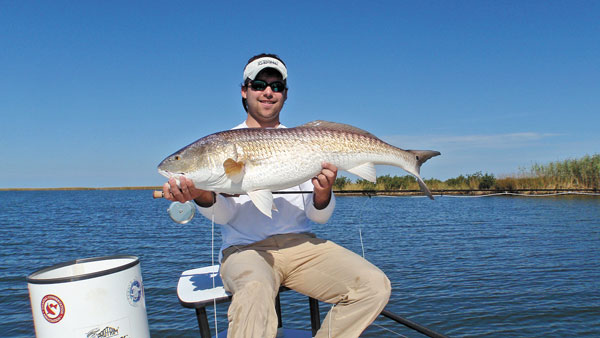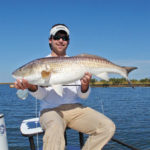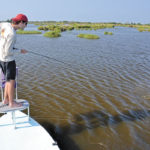
It’s prime time in the redfish capital of the world. From now through late December, flyrodders will flock to the marshes to stalk their spotted adversaries.
What makes this time of year so special?
Shrimp, minnows and small crabs return to the shallow marshes. As the water temperatures continue to drop, oxygen levels get higher. Redfish feed more aggressively. Cooler water also holds less suspended organics and sediments — and clear water favors the fly angler.
No one is more anxious for fall fishing than Barret Bertucci of Lafayette. He’s infatuated with that red siren of the marsh — the Spottail Diva.
Barret is among a growing number of young flyfishers in our state. Unlike most, he’s not a recent convert.
“My first glimpse of fly fishing came while I was in middle school,” he said. “One Saturday on ESPN, I watched Tom Brokaw and Jose Wejebe sightcasting to redfish in Hopedale. I knew then this was something I was destined to do.”
Barret’s grandfather lived in Bay St. Louis and pursued “green trout” and other freshwater gamefish on the fly. He gave Barret a fiberglass rod and tutored him on casting and techniques. Later in high school, he received his first graphite fly rod. It made a big difference in his casting and enthusiasm for the sport.
For years, Barret enjoyed catching bull bream on Accardo poppers. But redfish were always in the back of his mind.
His stepdad was a cousin to Capt. Blaine Townsend, a well-known fly fishing guide out of Chauvin. Together they made a charter trip in 2002. Barret may have hooked his first red that day, but it was the red who hooked Barret for life.
The experience was far greater than he imagined. Over the next few years, Barret continued to learn about flyfishing tactics from Townsend and other guides, like Capt. Rich Waldner. At the same time, he was learning to improve his overall knowledge of the sport through YouTube and internet forums. He even bought a saltwater-capable vise so he could tie the unique flies our native redfish crave.
Shortly after college, he bought his first kayak. It was only 8 feet long, but enough for him to fish ponds around Lafayette and become comfortable as a strictly fly fisherman.
Three years ago, he upgraded to a Native Ultimate kayak. This boat was more than marsh-capable; it allowed him to do stand-up fishing.
“Sightcasting is so addictive,” he said. “You see so many fish you didn’t know were there.
“I love fishing clear water, but even in low visibility you can see the shadows and dorsal patterns. And there’s that surge of adrenline you get when a red flares its gills and inhales your fly!”
Barret wanted to learn new waters. Now working as an independent broker for an oil-and-gas company, he was able to scrape some money aside for a small skiff.
With his new boat, Barret took the maiden voyage down to Pointe-aux-Chene, where he caught seven reds. Soon he was fishing every weekend, from Sabine Refuge to the Pearl River, and even around Bay St. Louis in Mississippi.
“The only place I haven’t yet fished for reds is Vermilion Bay,” he said. “I’ve been to places no one ever talks about and found beaucoup fish.
“I think I enjoy exploring new waters as much as catching fish itself.”
During this period, Barret’s tackle upgraded as well. He started with a custom Sage 8-weight, then moved to a Loomis CrossCurrent, and later added a TFO TiCR 6-weight and TiCRx 8-weight as backup. He has found that quality tackle really helps in accurate casts and bringing fish to the boat quickly.
When it comes to flies, there’s a clear-cut favorite: poppers.
“The visual stimulation of watching that head come out the water is amazing,” said Barret. “It doesn’t matter to me that there are fewer hookups.
“Big or small, any fish that hits a popper makes my day.”
That’s not to say he’s strictly a topwater dude. His other favorites include the Lefty’s Half-and-Half (half Clouser, half Deceiver) and his own creation, the Four-Eyed Flugly. The Flugly has rubber legs on front, hackle and a marabou tail. It’s been responsible for his biggest red yet on fly — 32 pounds.
“My flies won’t win any tying contests,” he said. “But they hold up and catch fish.
“Two of my frequent fishing buddies are Ron Begnaud and Kirk Dietrich, both great fly tiers and fine fishermen. I tease them by saying they’re teaching me how to tie flies and I’m teaching them how to catch fish.”
Joking aside, Barret admits he has taken on a protege — his younger brother Michael. He enjoys poling him around the marsh.
“Michael isn’t the best at casting a fly, but he has a sixth sense when it comes to fish,” said Barret. “He’s so casual about it.
“He can outcatch me at times, and when he does catch one, he loves to goof off.”
Over the last five years, I’ve seen Barret grow from a newbie to someone others seek advice from. Despite his near-expert status, he claims there’s still much to learn.
“I’d really like to get better at catching speckled trout,” he said.
That day may have to wait. Barret had just returned from a trip with another frequent partner, Blake LeBlanc. He and Blake found reds blowing up on poppers most of the morning. The only thing lacking was size. But he knows that the surge from Tropical Storm Lee has pushed bulls into the marsh. It’s only a matter of time before they show up.
“I release most of my fish, and never put any in the freezer,” he said. “When friends ask why, I tell them it’s my excuse to go every weekend.”
Our future looks bright with minds like that.




